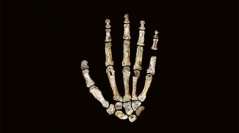

 Comptes Rendus Palevol
23 (28) - Pages 441-451
Comptes Rendus Palevol
23 (28) - Pages 441-451Morphology evolves through modifications to growth and development, yet inferences about ontogeny of extinct organisms are often limited by small and fragmentary fossil samples. The remarkable circumstances and preservation of Homo naledi Berger et al., 2015 material from Rising Star Cave, South Africa allow unique insights into the prenatal period of growth and development. We focus here on what a nearly complete adult H. naledi hand skeleton can tell us about embryonic pattern formation. On the one hand, it has been proposed that the proportional lengths of phalanges within a digit are established by a reaction-diffusion mechanism that can be described mathematically by the “inhibitory cascade” model. On the other hand, the proportional lengths of the second and fourth digits are mediated by prenatal exposure to sex hormones, and may serve as a biomarker for social behavior. Viewed through the lens of development, the H. naledi hand suggests that a simple developmental shift could have facilitated the evolution of manual dexterity in early hominins. In addition, H. naledi presents the highest ratio of second to fourth digit of all known fossil hominins, which may reflect reduced aggression compared to other fossil Homo Linnaeus, 1758. The remarkable preservation of the H. naledi hand skeleton provides a unique view of life before birth.
Hominin, ontogeny, development, phalanx, prenatal androgens